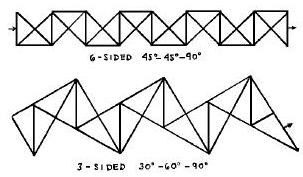| The Public Paperfolding History Project
x |
|||||||
| Bronzeflexagons | |||||||
| This
page attempts to give a broad outline of what is known
about the origin and history of Bronzeflexagons, which
are flexagons whose leaves are 60/30/90 degree, or
bronze, triangles. Please contact me if you know any of
this information is incorrect, if you have any other
information that should be added or are able to supply a
copy of any of the articles referred to which I have not
seen. Thank you. It is worth noting that my interest in and knowledge of flexagons mostly relates to their use as entertainments, magic effects, puzzles and as a form of recreational paperfolding. While I have included references to mathematical articles, I am not a competent mathematician and have not attempted a history of the mathematical understanding of flexagons. ********** 1962 In his 'Flexagons Inside Out', Les Pook refers to a 'comprehensive report, at the serious mathematics level, by Conrad and Hartline (1962) and goes on to give a link to a document which leads to a report called 'The Theory of the Flexagon' by A S Conrad (Hartline is not mentioned) published by RIAS (the Research Institute for Advanced Studies in Baltimore). This report was rescued from obscurity by Harold V McIntosh and states that it is 'A faithful reproduction of a RIAS Miscellaneous Publication of the same title, apparently later numbered RIAS Technical Report 60-24.' This report is mainly a discussion of the hexaflexagon family, but there is also a chapter on other flexagons which illustrates strips for a silverflexagon (and a bronze flexagon). Their properties are not, however, discussed.
As far as I know this is the first mention of a bronzeflexagon in the literature. ********** |
